| Pages:
1
2
3 |
Eddygp
National Hazard
   
Posts: 858
Registered: 31-3-2012
Location: University of York, UK
Member Is Offline
Mood: Organometallic
|
|
Presence of traces iron oxide minerals in limestone
I have been observing near where I live many CaCO3 rocks with what looks like alpha-Fe2O3 strips inside. Breaking a small rock
with this pattern at each side of the strip, i have noticed a layer of colourless crystals on each side of this formation. These crystals are
insoluble in water, non-reactive with acid and apparently orthogonal. I am thinking about how to test it for sulphates (bearing in mind that a
BaCl2 solution can be useless because of the insoluble nature of this crystal), silicates or even oxides, because most wet methods may be
inefficient.
So three main questions in mind:
1. - Does anyone know why this α-Fe2O3 formation is present always in the same way in limestone?
2. - Might it be Fe3O4 instead? (doubtful, because of the reddish colour)
3. - Can anyone suggest a test for anions and cations for this crystal layer, or have a guess?
Photos soon.
[Edited on 31-8-2013 by Eddygp]
there may be bugs in gfind
[ˌɛdidʒiˈpiː] IPA pronunciation for my Username |
|
|
bfesser
Resident Wikipedian
    
Posts: 2114
Registered: 29-1-2008
Member Is Offline
Mood: No Mood
|
|
What you describe sounds to me like <a href="http://www.mindat.org/min-26645.html" target="_blank">manganese dendrites</a> <img
src="../scipics/_ext.png" />; commonly found in limestone. A simple test with 3% H<sub>2</sub>O<sub>2</sub>(aq) should
distinguish them.
<img src="http://www.mindat.org/photos/0702938001268566787.jpg" width="400" />
(color varies from light brown to black)
I have a couple specimens in my collection; one purchased, one found. I'll try to get some photos on a sunnier day.
|
|
|
Eddygp
National Hazard
   
Posts: 858
Registered: 31-3-2012
Location: University of York, UK
Member Is Offline
Mood: Organometallic
|
|
No, I'm quite sure that it is not a dendritic mineral. It looks like many iron oxide crystals have formed inside some sort of groove in the rock, or
two different iron-coated limestone rocks have crushed together down in the crust.
there may be bugs in gfind
[ˌɛdidʒiˈpiː] IPA pronunciation for my Username |
|
|
ElectroWin
Hazard to Others
  
Posts: 224
Registered: 5-3-2011
Member Is Offline
Mood: No Mood
|
|
if these crystals are silicates, they will dissolve in or at least be etched by hot conc. NaOH or KOH. but so will some other stuff like alumina and
zinc.
HF is another thing to try, if you're careful.
you might try digging one out and doing a flame test.
HCl will dissolve the calcium carbonate holding it in place.
[Edited on 2013-8-31 by ElectroWin]
|
|
|
plante1999
International Hazard
    
Posts: 1936
Registered: 27-12-2010
Member Is Offline
Mood: Mad as a hatter
|
|
Download survival chem here:
http://hclo3.weebly.com/others.html
The bead test rocks, and then the silver-sulphur test is a good choice.
Get some monosodium phosphate and borax.
I never asked for this.
|
|
|
IrC
International Hazard
    
Posts: 2710
Registered: 7-3-2005
Location: Eureka
Member Is Offline
Mood: Discovering
|
|
Excellent work plante. He might read these books:
http://books.google.com/books?id=iF7wAAAAMAAJ&pg=RA1-PA7...
http://books.google.com/books?id=1RwlAQAAIAAJ&pg=SL4-PA4...
Water (bearing minerals) flowing through limestone commonly leaves iron deposits. If I had to guess Fe is most likely what is being seen. Don't
overlook Manganese as well.
"Science is the belief in the ignorance of the experts" Richard Feynman
|
|
|
Eddygp
National Hazard
   
Posts: 858
Registered: 31-3-2012
Location: University of York, UK
Member Is Offline
Mood: Organometallic
|
|
Thank you! So it can be iron oxide due to some sort of reaction with the limestone (which left those colourless crystals as a result, probably?) while
flowing diluted in water. Interesting books there, IrC.
I'm checking that page right now, plante. Let's see what I can do with these crystals once I get them again as I have lost my previous sample.
Tomorrow I will begin to analyse those minerals.
there may be bugs in gfind
[ˌɛdidʒiˈpiː] IPA pronunciation for my Username |
|
|
bfesser
Resident Wikipedian
    
Posts: 2114
Registered: 29-1-2008
Member Is Offline
Mood: No Mood
|
|
Iron does all sorts of interesting geochemical tricks when in solution.
Here are some photos I took of iron staining in a porous calcite-cemented quartz sandstone in Interstate State Park, MN.
<table><tr><td valign="middle">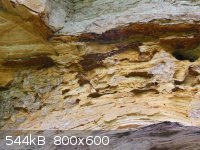 </td><td valign="middle"> </td><td valign="middle">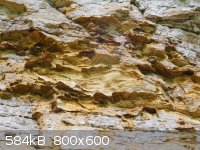 </td><td> </td><td>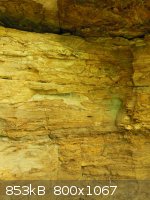 </td></tr></table>I thought I had something more relevant to add, but I just lost my train of thought. Sorry. </td></tr></table>I thought I had something more relevant to add, but I just lost my train of thought. Sorry.
|
|
|
IrC
International Hazard
    
Posts: 2710
Registered: 7-3-2005
Location: Eureka
Member Is Offline
Mood: Discovering
|
|
Next time you go bfesser take that counter. The best Carnotite rocks I have look nearly identical to the rock in the third pic. In the other thread I
forgot to mention sandstone, I think I just used the general term sedimentary rock.
"Science is the belief in the ignorance of the experts" Richard Feynman
|
|
|
bfesser
Resident Wikipedian
    
Posts: 2114
Registered: 29-1-2008
Member Is Offline
Mood: No Mood
|
|
Thanks for the tip, <strong>IrC</strong>. I plan to carry my geiger counter on <em>all</em> future geology
excursions—even if only to map background CPM with GPS. 
[edit] Being a MN State Park, I couldn't collect specimens, of course. But it would be neat to find them, regardless.
[Edited on 1.9.13 by bfesser]
|
|
|
Eddygp
National Hazard
   
Posts: 858
Registered: 31-3-2012
Location: University of York, UK
Member Is Offline
Mood: Organometallic
|
|
If I dissolve this sample in HCl and it did contain iron(III) oxide, this would also dissolve yielding a solution of everything... and losing the
possibility of getting the compound.
EDIT: Attached a photo to this post. It's just a small sample of a big white rock with that brownish-reddish line from side to the other as well as
some other minor ones.
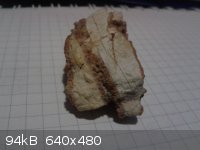
[Edited on 2-9-2013 by Eddygp]
there may be bugs in gfind
[ˌɛdidʒiˈpiː] IPA pronunciation for my Username |
|
|
plante1999
International Hazard
    
Posts: 1936
Registered: 27-12-2010
Member Is Offline
Mood: Mad as a hatter
|
|
First try the phosphate/borax bead test, if inconclusive, try wet chemistry thiocyanate test.
Don't forget the silver-sulphur test!
Tell us the results please.
I never asked for this.
|
|
|
bfesser
Resident Wikipedian
    
Posts: 2114
Registered: 29-1-2008
Member Is Offline
Mood: No Mood
|
|
<strong>Eddygp</strong>, it's difficult to make out anything in that photo. Try getting stronger illumination and setting your camera to
<a href="https://en.wikipedia.org/wiki/Macro_photography" target="_blank">macro</a> <img src="../scipics/_wiki.png" /> mode.
[edit] I tried tweaking the levels a bit in Photoshop. How's this in terms of color reproduction? Is it close to actual?
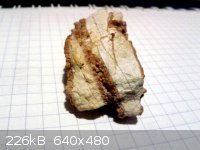
[second edit] Strictly from the photo; it looks a lot like iron-stained calcite (see second attached photo) to me. Have you tried an acid test on
the mineralized zone? Macro photos would be extremely helpful, though...
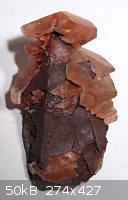
[Edited on 2.9.13 by bfesser]
|
|
|
Eddygp
National Hazard
   
Posts: 858
Registered: 31-3-2012
Location: University of York, UK
Member Is Offline
Mood: Organometallic
|
|
That colour is exactly the same one I see. I'll take a photograph of the actual mineral face, looks like it broke off the rock on that part. I was
taking photos with my mobile phone, so well... I guess I'll get the camera out.
EDIT: I found something that might be useful: http://en.wikipedia.org/wiki/Vein_(geology) It probably is what I'm looking for, and calcite does that
too. My bad, it actually looks like iron-stained calcite... I guess I thought it was too easy to be true and discarded it as a possibility.
[Edited on 3-9-2013 by Eddygp]
there may be bugs in gfind
[ˌɛdidʒiˈpiː] IPA pronunciation for my Username |
|
|
bfesser
Resident Wikipedian
    
Posts: 2114
Registered: 29-1-2008
Member Is Offline
Mood: No Mood
|
|
Don't be discouraged, it could be something else; wait until you've conducted some conclusive tests/analyses. I was merely hypothesizing based on a
simple visual observation. However, calcite is going to be the most common mineralization you find in limestone/dolostone, and Fe-staining is also
quite common. A close-up photo of the crystals would help—and pretty pictures are always appreciated. Do you have other specimens (enough
to ship off one or two for independent analyses)?
Relevant Terms:
<a href="https://en.wikipedia.org/wiki/Calcite" target="_blank">Calcite</a> <img src="../scipics/_wiki.png" />
<a href="https://en.wikipedia.org/wiki/Dolostone" target="_blank">Dolostone</a> <img src="../scipics/_wiki.png" />
<a href="https://en.wikipedia.org/wiki/Druse_(geology)" target="_blank">Druse</a> <img src="../scipics/_wiki.png" />
<a href="https://en.wikipedia.org/wiki/Limestone" target="_blank">Limestone</a> <img src="../scipics/_wiki.png" />
<a href="https://en.wikipedia.org/wiki/Mineralization_(geology)" target="_blank">Mineralization</a> <img src="../scipics/_wiki.png"
/>
<a href="https://en.wikipedia.org/wiki/Vein_(geology)" target="_blank">Vein</a> <img src="../scipics/_wiki.png" />
<a href="https://en.wikipedia.org/wiki/Vug" target="_blank">Vug</a> <img src="../scipics/_wiki.png" />
[edit: added terms]
[Edited on 3.9.13 by bfesser]
|
|
|
Eddygp
National Hazard
   
Posts: 858
Registered: 31-3-2012
Location: University of York, UK
Member Is Offline
Mood: Organometallic
|
|
Quote: Originally posted by bfesser  | Don't be discouraged, it could be something else; wait until you've conducted some conclusive tests/analyses. I was merely hypothesizing based on a
simple visual observation. However, calcite is going to be the most common mineralization you find in limestone/dolostone, and Fe-staining is also
quite common. A close-up photo of the crystals would help—and pretty pictures are always appreciated. Do you have other specimens (enough
to ship off one or two for independent analyses)?
Relevant Terms:
<a href="https://en.wikipedia.org/wiki/Calcite" target="_blank">Calcite</a> <img src="../scipics/_wiki.png" />
<a href="https://en.wikipedia.org/wiki/Dolostone" target="_blank">Dolostone</a> <img src="../scipics/_wiki.png" />
<a href="https://en.wikipedia.org/wiki/Druse_(geology)" target="_blank">Druse</a> <img src="../scipics/_wiki.png" />
<a href="https://en.wikipedia.org/wiki/Limestone" target="_blank">Limestone</a> <img src="../scipics/_wiki.png" />
<a href="https://en.wikipedia.org/wiki/Mineralization_(geology)" target="_blank">Mineralization</a> <img src="../scipics/_wiki.png"
/>
<a href="https://en.wikipedia.org/wiki/Vein_(geology)" target="_blank">Vein</a> <img src="../scipics/_wiki.png" />
<a href="https://en.wikipedia.org/wiki/Vug" target="_blank">Vug</a> <img src="../scipics/_wiki.png" />
[edit: added terms]
[Edited on 3.9.13 by bfesser] |
Yes, it probably is a druse, certainly a vein. I'm not sure if it's worth it to ship it, especially if we live far apart. However, I can get some more
specimens, maybe even larger size.
I'll carry on some analysis this afternoon to see if it is a carbonate, which would hopefully discard other minor possibilities. I do not have too
many chemicals at home, so I'll try to do some tests with it sacrificing some decigrams of my sample  I'll post the results, if any, later on. I'll post the results, if any, later on.
there may be bugs in gfind
[ˌɛdidʒiˈpiː] IPA pronunciation for my Username |
|
|
Eddygp
National Hazard
   
Posts: 858
Registered: 31-3-2012
Location: University of York, UK
Member Is Offline
Mood: Organometallic
|
|
The mysterious mineral dissolved in 9% acetic acid, with a very very thin iron(III) oxide suspension. This almost proves that it was just high-[Fe]
calcite.
there may be bugs in gfind
[ˌɛdidʒiˈpiː] IPA pronunciation for my Username |
|
|
bfesser
Resident Wikipedian
    
Posts: 2114
Registered: 29-1-2008
Member Is Offline
Mood: No Mood
|
|
I wouldn't say that it "almost proves" that it's calcite, merely that it <em>could be</em> calcite. Did you observe effervescence? What
leads you to believe that the suspended material was indeed iron(III) oxide? You wouldn't happen to have some <a
href="https://en.wikipedia.org/wiki/Eriochrome_Black_T" target="_blank">Eriochrome Black T</a> <img src="../scipics/_wiki.png" />,
would you?
|
|
|
Eddygp
National Hazard
   
Posts: 858
Registered: 31-3-2012
Location: University of York, UK
Member Is Offline
Mood: Organometallic
|
|
Quote: Originally posted by bfesser  | | I wouldn't say that it "almost proves" that it's calcite, merely that it <em>could be</em> calcite. Did you observe effervescence? What
leads you to believe that the suspended material was indeed iron(III) oxide? You wouldn't happen to have some <a
href="https://en.wikipedia.org/wiki/Eriochrome_Black_T" target="_blank">Eriochrome Black T</a> <img src="../scipics/_wiki.png" />,
would you? |
I did observe effervescence. I do not have Eriochrome Black T... but well, I think that calcite is the most probable mineral, due to the location,
formation type and everything. If I can do anything else with my primitive equipment, tell me. I still have the suspension, so I could dissolve it in
dilute HCl to yield CaCl2 and FeCl2 too, if it was the case.
Is there any other possible mineral with the same characteristics? Should I do a flame test (bearing in mind that just a little sodium would ruin the
whole test)?
[Edited on 3-9-2013 by Eddygp]
there may be bugs in gfind
[ˌɛdidʒiˈpiː] IPA pronunciation for my Username |
|
|
bfesser
Resident Wikipedian
    
Posts: 2114
Registered: 29-1-2008
Member Is Offline
Mood: No Mood
|
|
Does it exhibit the expected <a href="https://en.wikipedia.org/wiki/Mineral_cleavage" target="_blank">rhombohedral cleavage</a> <img
src="../scipics/_wiki.png" /> and <a href="https://en.wikipedia.org/wiki/Birefringence" target="_blank">double refraction</a> <img
src="../scipics/_wiki.png" />? How about the <a href="https://en.wikipedia.org/wiki/Mohs_scale_of_mineral_hardness" target="_blank">Mohs
hardness</a> <img src="../scipics/_wiki.png" />? There's no need to resort to more complex tests if you can confirm the identity of a
mineral by trivial means. Also, if you have a suitable balance or scale, try determining the <a
href="https://en.wikipedia.org/wiki/Specific_gravity" target="_blank">specific gravity</a> <img src="../scipics/_wiki.png" />.
[Edited on 4.9.13 by bfesser]
|
|
|
Eddygp
National Hazard
   
Posts: 858
Registered: 31-3-2012
Location: University of York, UK
Member Is Offline
Mood: Organometallic
|
|
Quote: Originally posted by bfesser  | Does it exhibit the expected <a href="https://en.wikipedia.org/wiki/Mineral_cleavage" target="_blank">rhombohedral cleavage</a> <img
src="../scipics/_wiki.png" /> and <a href="https://en.wikipedia.org/wiki/Birefringence" target="_blank">double refraction</a> <img
src="../scipics/_wiki.png" />? How about the <a href="https://en.wikipedia.org/wiki/Mohs_scale_of_mineral_hardness" target="_blank">Mohs
hardness</a> <img src="../scipics/_wiki.png" />? There's no need to resort to more complex tests if you can confirm the identity of a
mineral by trivial means. Also, if you have a suitable balance or scale, try determining the <a
href="https://en.wikipedia.org/wiki/Specific_gravity" target="_blank">specific gravity</a> <img src="../scipics/_wiki.png" />.
[Edited on 4.9.13 by bfesser] |
I'm afraid that the crystals are way too small for the refraction test, as well as near-opaque, one of the most useful to determine calcite. However,
I tested its Mohs hardness and to my surprise, it's around 2-3, as I was able to scratch it with a fingernail and with fluorite too. Rhombohedral
cleavage.
[Edited on 4-9-2013 by Eddygp]
there may be bugs in gfind
[ˌɛdidʒiˈpiː] IPA pronunciation for my Username |
|
|
bfesser
Resident Wikipedian
    
Posts: 2114
Registered: 29-1-2008
Member Is Offline
Mood: No Mood
|
|
It's a safe bet that you've got calcite (dolomite would be harder, at Mohs 3.5-4). You shouldn't be able to scratch it with a fingernail, though.
Unless you're pressing hard enough to actually cause cleavage in the cyrstal. It would be interesting to continue on and identify your suspension, if
possible. Thoughts on how to proceed? Also, do you plan to take more detailed photos?
|
|
|
Eddygp
National Hazard
   
Posts: 858
Registered: 31-3-2012
Location: University of York, UK
Member Is Offline
Mood: Organometallic
|
|
Yes, I'll take two more photos tomorrow, because I do not have time today. I will see what to do with my suspension, first get whatever the metal is
into solution and then do some wet ionic tests.
there may be bugs in gfind
[ˌɛdidʒiˈpiː] IPA pronunciation for my Username |
|
|
12AX7
Post Harlot
    
Posts: 4803
Registered: 8-3-2005
Location: oscillating
Member Is Offline
Mood: informative
|
|
Pyrite in shale and slate comes to mind; I don't recall that pyrite is very common in limestone, but shale layers are common. Such iron-bearing beds
could be oxidized into rust (or staining other minerals forming at the same time) quite easily.
The marked difference between layers in your specimen makes me think water infiltration along a bedding layer; this would be typical of midwestern US
limestones. If this is the case, then an iron (and other stuff) bearing shale layer is unlikely, and the filler could be anything the water brought
along for the ride.
I've seen aragonite in that color. Don't know how common it is in limestones, but it does occur as an alteration of calcium carbonate.
Tim
|
|
|
Eddygp
National Hazard
   
Posts: 858
Registered: 31-3-2012
Location: University of York, UK
Member Is Offline
Mood: Organometallic
|
|
So here they come, three photos from different angles.
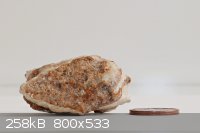 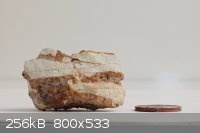 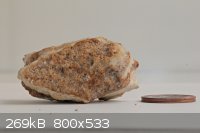
there may be bugs in gfind
[ˌɛdidʒiˈpiː] IPA pronunciation for my Username |
|
|
| Pages:
1
2
3 |